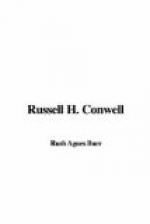It was not only a question of giving, even small sums. What was given must be saved in some way. Few could give outright and not feel it. Incomes for the most part just covered living expenses, and expenses must be cut down, if incomes were to be stretched to build a church. So these practical people put their wits to work to see how money could be saved. Walking clubs were organized, not for vigorous cross country tramps in a search for pleasure and health, but with an earnest determination to save carfare for the building fund. Tired men with muscles aching from a hard day’s work, women weary with a long day behind the counter or typewriter, cheerfully trudged home and saved the nickels. Women economized in dress, men who smoked gave it up. Vacations in the summer were dropped. Even the boys and girls saved their pennies as little Hattie Wiatt had done, and the money poured into the treasury in astonishing amounts, considering how small was each individual gift. All these sacrifices helped to endear the place to those who wove their hopes and prayers about it.
A fair was given in a large hall in the centre of the city which brought to the notice of many strangers the vigorous work the church was doing and netted nearly five thousand dollars toward the building fund. It was a fair that went with a vim, planned on business lines, conducted in a practical, sensible fashion.
Another effort that brought splendid results was the giving out of little earthen jugs in the early summer to be brought to the harvest home in September with their garnerings. It was a joyous evening when the jugs were brought in. A supper was given, and while the church members enjoyed themselves at the tables, the committee sat on the platform, broke the jugs, counted the money and announced the amount. The sum total brought joyous smiles to the treasurer’s face.
Innumerable entertainments were held in the church and at homes of the church members. Suppers were given in Fairmount Park during the summer. Every worthy plan for raising money that clever brains could devise and willing hands accomplish was used to swell the building fund.
Thus the work went ahead, and in September, 1886, the lot on which The Temple now stands at Broad and Berks was purchased at a cost of twenty-five thousand dollars. Thus encouraged with tangible results, the work for the building fund was pushed, if possible, with even greater vigor. Ground was broken for The Temple March 27, 1889. The corner stone was laid July 13, 1890, and on the first of March, 1891, the house was occupied for worship.
The only large amount received toward the building fund was a gift of ten thousand dollars on condition that the church be not dedicated until it was free of debt. In a legal sense, calling a building by the name of the congregation worshipping in it is a dedication, and so the building, instead of being called The Grace Baptist Church, was called the Baptist Temple, a name which will probably cling to it while one stone stands upon another.




